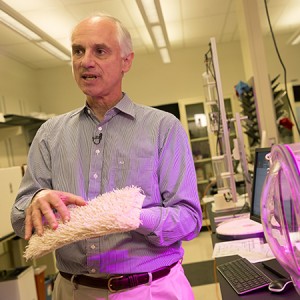April 21, 2016
 Arizona State University’s President Michael Crow has hired Center for Negative Carbon Emissions Director Klaus Lackner twice.
Arizona State University’s President Michael Crow has hired Center for Negative Carbon Emissions Director Klaus Lackner twice.
The first time was when Crow was vice provost at Columbia University. He attracted Lackner in 2001 from Los Alamos National Laboratory to join Columbia's Earth Institute and become a professor.
Crow knew he was hiring a big picture thinker: Lackner’s interest in self-replicating machine systems had been recognized by Discover magazine in 1997 as one of seven ideas that could change the world, and his work in mineral sequestration of carbon dioxide in silicate minerals appeared in the Intergovernmental Panel on Climate Change assessment report.
At the Earth Institute, Lackner brought his expertise as a theoretical physicist during the summer at the Biosphere – then owned by Columbia – in Tuscon, AZ and met colleague and CNCE executive director Allen Wright. Wright and Lackner’s theoretical discussions of removing carbon dioxide from the atmosphere evolved in 2003 into co-founding the first privately held company that set out to discover the most effective way to build a technology that could scale to address the scope of global emissions.
By 2008, they had discovered several promising approaches, but unfortunately the global economy was not prepared to privately fund efforts to scale up the technology, and the company shuttered its doors. Lackner’s research in air capture continued at Columbia, where he was also the director at the Lenfest Center for Sustainable Energy.
While there were advances in the research in the feasibility and underlying molecular dynamics of technology that Wright and Lackner co-invented at the Lenfest Center, they lacked a larger scale demonstration that could prove beyond ambiguity the feasibility and usefulness of systems that can affordably capture carbon dioxide from the atmosphere.
Under the premise of developing a center to demonstrate air capture systems in a public environment, Crow hired Lackner a second time. His efforts at CNCE are focused on improving novel methods to remove carbon dioxide from the atmosphere, integrating air capture technology with applications that use carbon dioxide, exploring safe and permanent disposal options for carbon dioxide, and identifying opportunities for automation and scaling.
Lackner’s research interests extend beyond air capture to closing the carbon cycle with zero-emission power plant design, using engines as a modular reactor, carbon foot-printing, innovative energy and infrastructure systems and their scaling properties, the role of automation, robotics and mass-manufacturing in down-scaling infrastructure systems, and energy and environmental policy.

